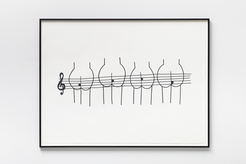OLAF BREUNING
COLD ANIMALS
05.11 – 17.12.2016
Nils Stærk is pleased to announce Olaf Breuning’s solo exhibition Cold Animals with new large drawings along with absurd and humorous hand-painted ceramic sculptures.
Since the beginning of his career Breuning has worked with drawings as a starting point for his photography, sculptures and film production. Drawing as an independent media in Breuning’s production has now for more than 10 years been an integrated part of his exhibitions, while his ceramic sculptures, like a tree-dimensional portrayal of his drawings, are new to the artistic practice.
Brett Littman, director of The Drawing Center New York, has traced the process behind Breuning’s seemingly simple and immediate drawings and his general practice and inspirations in an interview from August 2016.
Excerpts from the interview:
Your drawing practice is very regimented. I know that you used to draw at Balthazar, a restaurant in SoHo, where you would go every morning for breakfast. You would have a specific kind of notebook and the B2 pencil that you use to make your drawings. You also did a series of drawings on the Queen Mary during two cruises from NY to the UK. Why do you need this kind of structure to draw?
Well, in the beginning of my career I did not take drawing seriously as an art medium. I generally used drawings as plans for my photographs. I would make very detailed drawings for my very complicated big photographs. (…) All of a sudden, I looked at these drawings more seriously and people around me started to look at them too and think that they were pretty cute and good – that encouraged me.
However, for me sitting in front of a blank piece of paper with a pen alone in a studio isnotagoodwaytowork.(…)Ihadto find that place where I can focus on drawing —a busy place like Balthazar or on the Queen Mary — where I could observe people and generate ideas.
I like people. I want to tell stories about humans and the tragedy of life. I feel a lot of empathy for the worldview of someone like Woody Allen or Larry David. I am a very optimistic person, but at the same time I want to deal with things that are kind of sad like death and war. When I am in Balthazar and I see a waitress serving something, I might have an idea of someone serving food in a French maid costume, then all of a sudden my brain starts to work. The thing is that I fish for ideas. I look out there and I see certain things, and suddenly one small idea pops into my head and I try to take that idea and turn it into a snowball that starts an avalanche. (…)
When I have a successful drawing session I am pretty sure that in my case it has a lot to do with my neuro- biological state of mind, you know? Sometimes I am just enthusiastic and stuff just floats out, and sometimes I just sit in Balthazar and try to make a drawing and make a circle and then nothing more happens. (…)
What makes a drawing successful for you? Does the horizon of success for you end with you just being satisfied with the drawing or the drawing communicating something specific?
Being satisfied with the drawing personally is where the horizon of success ends for me. (…) I’m not someone who really needs other people’s opinions about a work. People can always say whatever they want about my work because we have seven billion people on the planet. One person thinks this and another person thinks that and I am just fine with that.
The interview will be published in its entirety in the forthcoming book Olaf Breuning – Drawings published by VfmK, Verlag für modern Kunst
Olaf Breuning (b. 1970, Schaffhausen in Switzerland) is educated from Zürich University of the Arts, but lives and works in New York, USA. Most recent institutional solo exhibitions include: NRW-Forum, Düsseldorf, Kunsthall Stavanger. Haifa Museum of Art, Zentrum Paul Klee, Bern, Palais de Tokyo, Paris and Kunstmuseum Luzern. Represented in public collections like Louisiana Museum of Modern Art, DK. Kunsthall Hamburg, DE. Musée d’Art Moderne et Contemporaine, FR among others.





